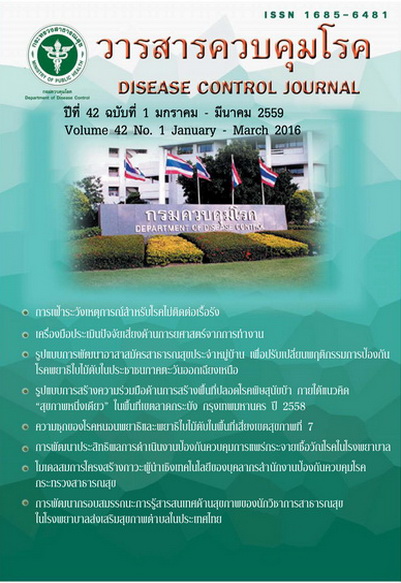Event-based surveillance for non-communicable diseases
DOI:
https://doi.org/10.14456/dcj.2016.27Keywords:
event-based surveillance, , non-communicable disease, determinantsAbstract
Event-based surveillance is an epidemiological surveillance which for more rapid detection of abnormal event. In general, event-based surveillance system was applied mainly for communicable disease. To suitably apply the surveillance to non-communicable disease (NCDs), disease occurrence mechanism, determinants and also transmission mode of NCDs should be clarified. The 2 main components of event-based surveillance for NCDs are (1) health and behavior of human and (2) The environmental component including business marketing, culture, festival, and natural disaster. To earlier detect and rapidly response an abnormal event, the surveillance system should include community network or civil society and the clear operational guideline should be developed. There are 3 existing main surveillance network related to NCDs in Thailand including Surveillance Rapid Response Network (SRRT), student network for food and drug safety surveillance and civil society network who responsible for alcohol act violation surveillance. However, the SRRT mainly focus only on the event of communicable disease, the NCDs concept just has been introduced into the network for couple of year. Ministry of Public Health has concerned of event detection by people, so Department of Disease Control opened hotline so that people can immediately notify when they found any abnormal events. However, there is currently no government body that is responsible to the whole NCD event-based surveillance and no clear linkage between civil society network and government. Therefore, Thailand should develop NCD event-based surveillance system which systemically link to community and civil society and should develop standard tools or guideline which cover all processes of event detection, data management, reporting, and how to investigate NCD event. The human capacity improvement strategies to better support the NCD event-based surveillance in all levels should be performed.
Downloads
References
2. World Health Organization. A guide to establish event-based surveillance. Geneva: World Health Organization; 2008.
3. World Health Organization. WHO Technical Consultation on event-based surveillance. Lyon: World Health Organization; 2013.
4. World Health Organization. The global burden of diseases updated 2004. Geneva: World Health Organization; 2008.
5. สำนักงานพัฒนาสุขภาพระหว่างประเทศ. รายงาน ภาระโรคและการบาดเจ็บของประชากรไทย พ.ศ. 2552. นนทบุรี : เดอะกราฟิโกซิสเต็มส์; 2555.
6. ศูนย์วิจัยและจัดการความรู้เพื่อการควบคุมยาสูบ มหาวิทยาลัยมหิล. รายงานสรุปสถานการณ์เฝ้าระวังเพื่อการควบคุมการบริโภคยาสูบ 5 มิติ. กรุงเทพมหานคร: เจริญดีมั่นคงการพิมพ์; 2558.
7. World Health Organization. Disease outbreaks [Internet]. [cited 2015 Aug 10]. Available from: http://www.who.int/topics/disease_outbreaks/en/
8. World Health Organization. Rapid risk assessment of acute public health events. Geneva: World Health Organization; 2012.
9. Holt JB, Mokdad AH, Ford ES, Simoes EJ, Mensah GA, Bartoli WP. Use of BRFSS data and GIS technology for rapid public health response during natural disasters. Preventing Chronic Disease 2008;5:A97.
10. World Health Organization. International Code of Marketing of Breast-milk Substitutes: Geneva: World Health Organization; 1981.
11. Bender AP, Parker DL, Johnson RA, Scharber WK, Williams AN, Marbury MC, et al. Minne¬sota highway maintenance worker study: cancer mortality. Am J Indus Med 1989;15:545-56.
12. Cannon SB, Veazey JM Jr, Jackson RS, Burse VW, Hayes C, Straub WE, et al. Epidemic kepone poisoning in chemical workers. Am J Epidemiol 1978;107:529-37.
13. Baptiste MS, Rothenberg R, Nasca PC, Janerich DT, Stutzman CD, Rimawi K, et al. Health ef¬fects associated with exposure to radioactively contaminated gold rings. J Am Acad Dermatol 1984;10:1019-23.
14. สำนักระบาดวิทยา กรมควบคุมโรค กระทรวงสาธารณสุข. ระบบเฝ้าระวัง 5 กลุ่มโรค 5 มิติ. กรุงเทพมหานคร: บริษัท ฮีซ์ จำกัด; 2557.
15. สำนักระบาดวิทยา กรมควบคุมโรค. คู่มือเฝ้าระวังเหตุการณ์และควบคุมโรคระบาดในชุมชน สำหรับทีมเฝ้าระวังสอบสวนเคลื่อนที่เร็ว (SRRT) เครือข่ายระดับตำบล อาสาสมัครสาธารณสุข ผู้นำชุมชน และประชาชนทั่วไป. กรุงเทพมหานคร: โรงพิมพ์ชุมนุม สหกรณ์การเกษตรแห่งประเทศไทย; 2554.
16. สำนักระบาดวิทยา กรมควบคุมโรค. มาตรฐานและแนวทางปฏิบัติงานทีมเฝ้าระวังสอบสวนเคลื่อนที่เร็ว (SRRT) ฉบับปรับปรุงใหม่ 2555. กรุงเทพมหานคร: โรงพิมพ์ชุมนุมสหกรณ์การเกษตรแห่ง ประเทศไทย; 2555.
Downloads
Published
How to Cite
Issue
Section
License
Articles published in the Disease Control Journal are considered as academic work, research or analysis of the personal opinion of the authors, not the opinion of the Thailand Department of Disease Control or editorial team. The authors must be responsible for their articles.






